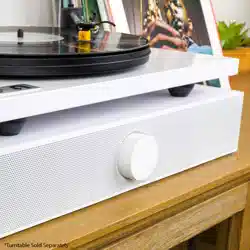Loading ...

Thank you for purchasing Spinbase.
If you’re new to vinyl, or returning to it after a few years, there are some important things to know:
The turntable Phono cartridge is the device on the end of the tonearm that converts record grooves to an
electrical signal. The most commonly equipped cartridges are Magnetic and Ceramic. Spinbase is compatible
with both, but the connections are different. (Note: Some high-end cartridges, called Moving-Coil, are not
compatible with Spinbase.)
MAGNETIC CARTRIDGES - provide higher delity than their Ceramic siblings. They also track your records with
less weight and are better at preventing record wear. They provide very little electrical output and require a
circuit known as an RIAA preamplier to boost and equalize the signal. Spinbase has this preamplier built-in.
If your turntable has a Magnetic cartridge, connect it to the “Magnetic Phono” input on Spinbase. Ensure the
back switch is set to Line-In.
Some turntables also have their own preampliers built-in and do not require the use of the preamplier
in Spinbase. If your turntable has a switch on it marked “Line” and “Phono”, your turntable has a built-in
preamplier. You have two choices:
1. Switch your turntable to “Line” and plug it into the Line-In input on Spinbase; or,
2. Switch your turntable to “Phono” and plug it into the “Magnetic Phono” input, utilizing the preamplier in
Spinbase.
In most cases, plugging your turntable into the Spinbase Phono input and ensuring back switch is set to Line-
In will give the best sound. Try them both and use what sounds best to you.
CERAMIC CARTRIDGES - are generally found in lower priced turntables and record players. They do not
perform as well as a good magnetic cartridge, but can still give satisfying performance with Spinbase thanks
to its exclusive Ceramic Equalization feature. Ceramic cartridges have high output voltage, and turntables or
record players equipped with one should be plugged into the Line-In input on Spinbase. The sound quality will
be improved when setting the back switch to “ON”. If you are NOT using a Ceramic cartridge, leave the back
switch to the Line-In position.
SHORTING PLUGS - The shorting plugs supplied with Spinbase should remain plugged into the “Magnetic
Phono” input whenever it is unused, such as when you are using the Spinbase Line-Input or a Bluetooth device.
Failure to do this will result in excess electronic background noise.
STAYING GROUNDED - Because Magnetic Phono cartridges have such a low output, the Phono input is much
more sensitive to any noise or ground hum than other inputs. Because of this, many turntables are equipped
with a grounding wire or have a screw to attach one. If your turntable requires grounding, attach the grounding
wire from the ground thumbscrew on Spinbase to the ground screw on your turntable. Some turntables are not
equipped with ground wires, and instead have their ground supplied through the RCA plugs.
CONTACT SUPPORT - There are so many different turntables, record players and other sources available to use
with Spinbase that it’s impossible to cover all the possibilities here. If you have any operation, connection, or
performance questions or concerns don’t hesitate to reach out to us. We’re ready to help!
support@andoveraudio.com | +1 978.775.3670
FCC STATEMENT: This equipment has been tested and found to comply with the limits for a Class B digital device, pursuant to part 15 of the FCC
Rules. These limits are designed to provide reasonable protection against harmful interference in a residential installation. This equipment generates,
uses and can radiate radio frequency energy and, if not installed and used in accordance with the instructions, may cause harmful interference to
radio communications. However, there is no guarantee that interference will not occur in a particular installation. If this equipment does cause harmful
interference to radio or television reception, which can be determined by turning the equipment off and on, the user is encouraged to try to correct the
interference by one or more of the following measures:
—Reorient or relocate the receiving antenna.
—Increase the separation between the equipment and receiver.
—Connect the equipment into an outlet on a circuit different from that to which the receiver is connected.
—Consult the dealer or an experienced radio/TV technician for help.
